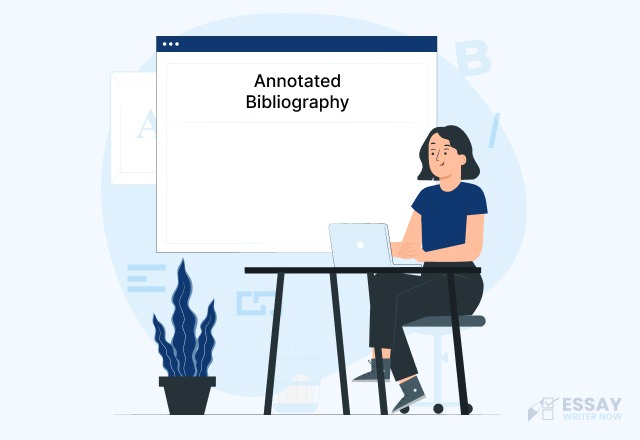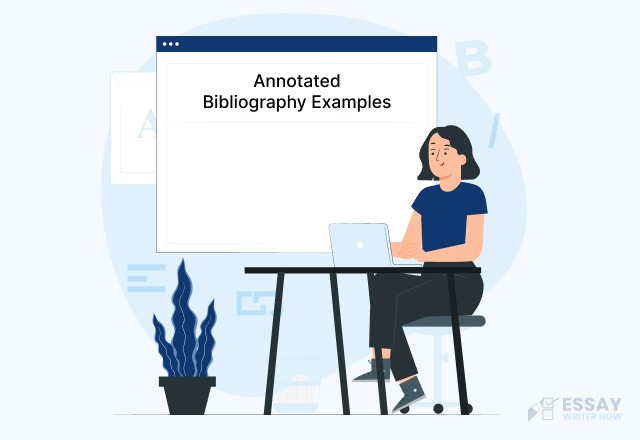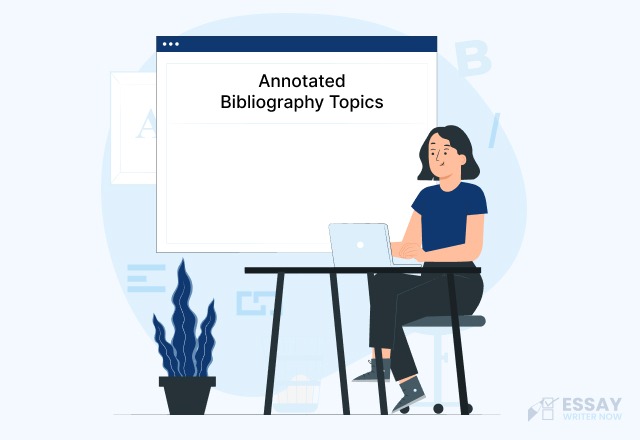What are Annotated Bibliographies?
An annotated bibliography is a detailed list of references with accompanying annotations that summarize, evaluate, and reflect on each source's relevance to your research. It typically serves multiple purposes: helping you organize your sources, providing a quick reference for future research, and demonstrating the depth and quality of your research to others.
What Are The Two Components Of An Annotated Bibliography?
An annotated bibliography consists of two main components:
Citation
This includes the bibliographic information of the source (author, title, publication date, etc.), formatted according to a specific citation style (e.g., APA, MLA, Chicago). Proper citation is crucial because it ensures that you give credit to the original authors.
It also allows your readers to locate the sources you have referenced. Each citation style has its own set of rules and conventions, so it’s important to follow the guidelines of the required style.
Annotation
This is a brief description and evaluation of the source. It typically includes a summary of the content, an assessment of the source’s credibility and relevance, and a reflection on its applicability to your research.
Annotations serve multiple purposes: they help you keep track of your sources, understand the main arguments and findings, and evaluate the source’s contribution to your research.
What Are The Four Different Types Of Annotations?
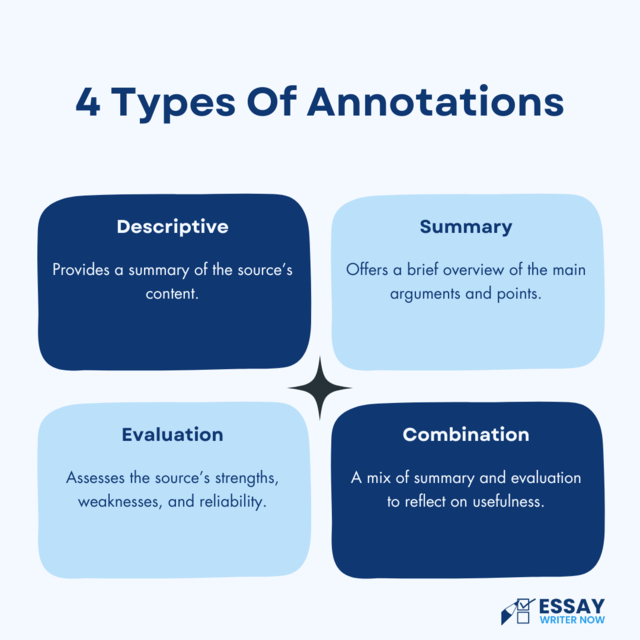
Annotations can be classified into four types:
Descriptive
Provides a summary of the source’s content. This type of annotation merely describes the source without evaluating its quality or relevance.
| For example, “This book provides a comprehensive overview of ancient Greek philosophy, covering major thinkers like Plato and Aristotle.” |
Summary
Offers a brief overview of the main arguments and points. A summary annotation goes a step further than a descriptive annotation by summarizing the key points and arguments presented in the source.
| For example, “The article discusses the impact of climate change on polar bear populations, arguing that melting ice caps significantly threaten their habitat and survival.” |
Evaluation
Assesses the source’s strengths, weaknesses, and reliability. An evaluative annotation not only summarizes the content but also provides a critical assessment of the source.
| For example, “This study offers valuable insights into renewable energy technologies. However, its limited sample size and lack of longitudinal data reduce the generalizability of its findings.” |
Combination
A mix of summary and evaluation, often including personal reflection on the source’s usefulness. This type of annotation combines elements of summary and evaluation, providing a comprehensive overview of the source.
| For example, “The book presents a thorough analysis of social media’s influence on modern communication. The author’s extensive research and clear writing make it a reliable resource. This source will be particularly useful for understanding the theoretical framework of my study.” |
Steps to Writing an Annotated Bibliography
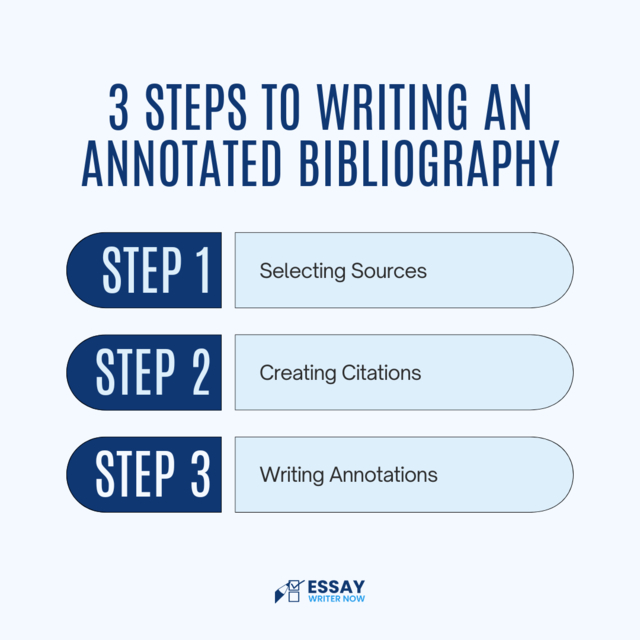
Here are some steps that you can follow to write your annotated bibliographies:
Step 1: Selecting Sources
Begin by choosing sources that are relevant to your research topic. Consider books, journal articles, and reputable websites. Ensure that each source you select contributes significantly to your understanding of the topic.
Use academic databases like Google Scholar to find credible sources. Evaluate each source for its reliability, credibility, and relevance to your research question.
Step 2: Creating Citations
Now you will create and format the citation according to the required style guide. Here are examples in different citation styles:
APA: Smith, J. A. (2020). The Impact of Climate Change on Coastal Ecosystems. Environmental Science Journal, 35(4), 234-256. doi:10.1234/esj.2020.345 Further details on APA Citations MLA: Smith, John A. "The Impact of Climate Change on Coastal Ecosystems." Environmental Science Journal, vol. 35, no. 4, 2020, pp. 234-256. Further details on MLA Citations ASA: Smith, John A. 2020. "The Impact of Climate Change on Coastal Ecosystems." Environmental Science Journal 35(4):234-256. doi:10.1234/esj.2020.345 Further details on ASA Citations IEEE: J. A. Smith, "The Impact of Climate Change on Coastal Ecosystems," Environmental Science Journal, vol. 35, no. 4, pp. 234-256, 2020. Further details on IEEE Citations Chicago: Smith, John A. 2020. The Impact of Climate Change on Coastal Ecosystems. Environmental Science Journal 35(4): 234-256. https://doi.org/10.1234/esj.2020.345 Further details on Chicago Citations Harvard: Smith, J.A., 2020. The Impact of Climate Change on Coastal Ecosystems. Environmental Science Journal, 35(4), pp.234-256. Available at: https://doi.org/10.1234/esj.2020.345 [Accessed 27 June 2024]. Further details on Harvard Citations |
Each style guide has specific rules for formatting different types of sources, such as books, journal articles, and online materials.
Be sure to pay close attention to details like punctuation, capitalization, and italicization.
Step 3: Writing Annotations
For each source, write an annotation that includes the following elements:
Summary
Briefly describe the main points and arguments of the source. Highlight the key findings, arguments, or theories presented by the author.
| For example, “This article examines the role of social media in political campaigns, arguing that platforms like Twitter and Facebook have transformed the way candidates engage with voters.” |
Evaluation
Assess the credibility, reliability, and relevance of the source. Consider factors such as the author’s qualifications, the publication’s reputation, and the date of publication.
| For example, “The author, a professor of political science, provides a well-researched analysis supported by extensive data. The article’s recent publication date ensures that it covers the latest developments in the field.” |
Reflection
Explain how the source contributes to your research. Does it support or contradict your thesis? How does it help shape your understanding of the topic?
| For example, “This source will be valuable for my research on digital marketing strategies, as it provides empirical evidence on the effectiveness of social media advertising.” |
Tips to Write Effective Annotations
Here are some tips you can follow to write perfect annotations:
Be Concise Yet Informative
When writing an annotation, your goal is to convey the essence of the source without being excessively verbose. Provide enough detail to give a clear understanding of the source’s content and its significance, but avoid unnecessary information that might obscure the main points.
Here are some strategies to achieve this balance:
Focus on Key Points
Highlight the main arguments, findings, or contributions of the source. Summarize these points succinctly.
Example:
| "This book provides a comprehensive overview of renewable energy technologies, focusing on wind, solar, and hydroelectric power. The author discusses the advantages and challenges of each technology." |
Avoid Redundancy
Eliminate any repetitive information or statements that do not add new value to the annotation.
Example:
| "The article analyzes the effects of urbanization on biodiversity, presenting data from multiple case studies. The findings indicate a significant decline in species diversity in urban areas." |
Prioritize Information
Decide what aspects of the source are most relevant to your research and emphasize those in your annotation.
Example:
| "This study offers valuable insights into the psychological impacts of social media usage among teenagers. The research highlights correlations between high usage and increased anxiety levels." |
Maintain Objectivity
Objective annotations are critical for providing a fair and balanced evaluation of your sources. Assess each source based on its merits rather than your personal biases or opinions.
Consider the following:
Use Evidence-Based Evaluation
Support your evaluation with specific examples or evidence from the source. This strengthens your assessment and adds credibility.
Example:
| "The author's argument is supported by extensive empirical data collected over a ten-year period, enhancing the reliability of the conclusions." |
Avoid Personal Opinions
Refrain from including subjective comments or opinions. Focus on factual and unbiased analysis.
Example:
| "The study presents a thorough examination of the economic impacts of climate change policies, using statistical models to project future trends." |
Consider Multiple Perspectives
Acknowledge different viewpoints presented in the source, providing a comprehensive evaluation.
Example:
| "While the author argues in favor of renewable energy adoption, the book also includes counterarguments from critics who question the feasibility and cost-effectiveness of these technologies." |
Provide Context
Annotations should explain why a source is relevant to your research. This involves connecting the source to your research question or thesis.
Here’s how to do it effectively:
Link to Research Objectives
Clearly state how the source contributes to your understanding of the topic or supports your thesis.
Example:
| "This article is crucial for my research on sustainable urban planning, as it provides a detailed analysis of green infrastructure initiatives in major cities." |
Highlight Relevance
Explain any unique insights or data the source provides that are particularly pertinent to your research.
Example:
| "The study's use of longitudinal data offers a unique perspective on the long-term effects of dietary habits on health, which is directly relevant to my thesis on nutrition and public health." |
Compare with Other Sources
If applicable, mention how this source complements or contrasts with other sources in your bibliography.
Example:
| "Unlike other studies that focus solely on economic factors, this research incorporates social and environmental dimensions, providing a more holistic view." |
Use Clear and Precise Language
Clear and precise language ensures that your annotations are easy to understand. Avoid jargon and complex sentences that might confuse readers.
Consider these tips:
Simplify Complex Ideas
Break down complicated concepts into simple, understandable language.
Example:
| "The article explains the process of photosynthesis in a straightforward manner, making it accessible to readers without a scientific background." |
Use Active Voice
Write in an active voice to make your annotations more direct and engaging.
Example:
| "The researcher conducted a series of experiments to test the hypothesis, providing clear evidence of the relationship between variables." |
Proofread
Review your annotations for clarity and precision, correcting any ambiguous or convoluted sentences.
Example:
| "After proofreading, ensure that each sentence is clear and contributes directly to the annotation's purpose." |
Common Mistakes to Avoid
Here are some common mistakes that most students make, but need to avoid, when writing annotated bibliographies:
Overly Long or Short Annotations
The length of your annotations should strike a balance between being too brief and excessively detailed. Aim for a length that provides enough detail without overwhelming the reader.
Here are some pitfalls to avoid:
Too Short
Annotations that are too brief may lack essential details and fail to convey the source’s relevance or value.
Example:
"This book discusses environmental issues." (Too brief and lacks detail) |
Too Long
Lengthy annotations can include unnecessary information, making it harder to identify the source’s key points. Stick to the main ideas and most significant aspects of the source.
Example:
"This comprehensive book covers every aspect of environmental science, including history, current issues, and future predictions, with detailed case studies, statistical analysis, and theoretical discussions, making it an invaluable resource for anyone interested in the field." (Too lengthy) |
Lack of Critical Analysis
An annotation that only summarizes the source without evaluating its credibility or relevance is incomplete. Critical analysis is essential for a comprehensive understanding.
Avoid these common mistakes:
No Evaluation
Simply describing the source without assessing its strengths and weaknesses fails to provide a complete picture.
Example:
"The book provides an overview of climate change impacts." (No evaluation) |
Superficial Analysis
Offering a shallow evaluation without supporting evidence does not add value. Provide in-depth analysis backed by specific examples from the source.
Example:
"The author makes several claims about climate change but does not support them with data." (Superficial analysis) |
Inconsistent Citation Styles
Consistency in citation style is crucial for a professional and credible bibliography. Avoid the following mistakes:
Mixing Styles
Using different citation styles within the same bibliography can confuse readers and detract from your credibility.
Example:
"Smith, J. A. (2020). The Impact of Climate Change on Coastal Ecosystems. Environmental Science Journal, 35(4), 234-256." followed by "Smith, John A. 'The Impact of Climate Change on Coastal Ecosystems.' Environmental Science Journal, vol. 35, no. 4, 2020, pp. 234-256." (Mixing APA and MLA) |
Incorrect Formatting
Failing to follow the specific rules of the required citation style can lead to inaccuracies. Double-check your citations for proper formatting, punctuation, and capitalization.
Example:
"Smith, J. A. (2020) The Impact of Climate Change on Coastal Ecosystems Environmental Science Journal 35(4): 234-256." (Incorrect APA formatting) |
Failing to Link the Source to Your Research
Each annotation should clearly explain the source’s relevance to your research. Avoid these common errors:
No Connection to Research
An annotation that does not explain how the source is relevant to your research question or thesis is incomplete.
Example:
"This book provides an overview of renewable energy technologies." (No connection to research) |
Vague Relevance
Providing a vague or generic explanation of the source’s relevance does not help readers understand its significance. Be specific about how the source contributes to your research.
Example:
"The book is useful for understanding energy." (Vague relevance) |
Annotated Bibliography Examples
Here are some detailed annotated bibliography examples for different citation styles to help improve your understanding.
MLA 9th Edition
Here are two examples of annotated bibliographies formatted according to MLA 9th edition:
Source Type: Book Source: Hackl, Cathy, Dirk Lueth, and Tommaso Di Bartolo. Navigating the Metaverse: A Guide to Limitless Possibilities in a Web 3.0 World. John Wiley & Sons, 2022. Annotation: This book provides a comprehensive guide to the emerging metaverse and its potential in the Web 3.0 era. The authors discuss various applications, opportunities, and challenges associated with virtual environments, offering valuable insights for businesses and technology enthusiasts looking to explore this new digital frontier. |
Source Type: Journal Article Source: Ke, Pu Chun, et al. "A Decade of the Protein Corona." ACS Nano, vol. 11, no. 12, 2017, pp. 11773-11776. Annotation: This article reviews the research progress made in understanding the protein corona over the past decade. The authors discuss how the protein corona forms around nanoparticles and its significant implications for nanomedicine and drug delivery. The review highlights the critical role of the protein corona in determining the biological interactions and fate of nanoparticles. |
MLA 8th Edition
Here are two examples of annotated bibliographies formatted according to MLA 8th edition:
Source Type: Book Source: Hackl, Cathy, et al. Navigating the Metaverse: A Guide to Limitless Possibilities in a Web 3.0 World. John Wiley & Sons, 2022. Annotation: Hackl, Cathy, Dirk Lueth, and Tommaso Di Bartolo's book serves as a detailed introduction to the metaverse, exploring its technological advancements and societal impacts. It is a useful resource for understanding the future of digital interactions and the potential of virtual worlds in various sectors. |
Source Type: Journal Article Source: Ke, Pu Chun, et al. "A Decade of the Protein Corona." ACS Nano, vol. 11, no. 12, 2017, pp. 11773-11776. Annotation: Ke, Pu Chun, et al. "A Decade of the Protein Corona." ACS Nano, vol. 11, no. 12, 2017, pp. 11773-11776. This article provides a comprehensive review of the research on the protein corona, which forms around nanoparticles in biological environments. The authors examine its composition, formation, and impact on the biological identity and functionality of nanoparticles, emphasizing its importance in nanomedicine. |
APA 7th Edition
Here are two examples of annotated bibliographies in APA format:
Source Type: Book Source: Hackl, C., Lueth, D., & Di Bartolo, T. (2022). Navigating the Metaverse: A Guide to Limitless Possibilities in a Web 3.0 World. John Wiley & Sons. Annotation: Hackl, C., Lueth, D., & Di Bartolo, T. (2022). Navigating the Metaverse: A Guide to Limitless Possibilities in a Web 3.0 World. John Wiley & Sons. This book explores the concept of the metaverse within the context of Web 3.0, discussing its applications, opportunities, and challenges. It provides practical insights for businesses and individuals interested in leveraging virtual environments for innovation and growth. |
Source Type: Journal Article Source: Ke, P. C., Lin, S., Parak, W. J., Weiss, P. S., & Davis, T. P. (2017). A decade of the protein corona. ACS Nano, 11(12), 11773-11776. https://doi.org/10.1021/acsnano.7b08008 Annotation: Ke, P. C., Lin, S., Parak, W. J., Weiss, P. S., & Davis, T. P. (2017). A decade of the protein corona. ACS Nano, 11(12), 11773-11776. https://doi.org/10.1021/acsnano.7b08008. This review article summarizes the significant findings and developments in the study of the protein corona over the past decade. The authors discuss its formation, properties, and implications for the use of nanoparticles in biomedical applications, particularly in drug delivery and diagnostics. |
IEEE Format
Here are two examples of annotated bibliographies formatted according to IEEE format:
Source Type: Book Source: C. Hackl, D. Lueth, and T. Di Bartolo, Navigating the Metaverse: A Guide to Limitless Possibilities in a Web 3.0 World. John Wiley & Sons, 2022. Annotation: C. Hackl, D. Lueth, and T. Di Bartolo, Navigating the Metaverse: A Guide to Limitless Possibilities in a Web 3.0 World. John Wiley & Sons, 2022. This book offers an in-depth look at the metaverse, discussing its development and potential within the Web 3.0 framework. It is a valuable resource for understanding the future of virtual interactions and digital economies. |
Source Type: Journal Article Source: P. C. Ke, S. Lin, W. J. Parak, P. S. Weiss, and T. P. Davis, "A Decade of the Protein Corona," ACS Nano, vol. 11, no. 12, pp. 11773-11776, 2017. Annotation: P. C. Ke, S. Lin, W. J. Parak, P. S. Weiss, and T. P. Davis, "A Decade of the Protein Corona," ACS Nano, vol. 11, no. 12, pp. 11773-11776, 2017. This paper reviews ten years of research on the protein corona, focusing on its formation around nanoparticles and its implications for nanomedicine. The authors provide an in-depth analysis of how the protein corona affects nanoparticle behavior and functionality. |
ASA Format
Here are two examples of annotated bibliographies formatted according to ASA format:
Source Type: Book Source: Hackl, Cathy, Dirk Lueth, and Tommaso Di Bartolo. 2022. Navigating the Metaverse: A Guide to Limitless Possibilities in a Web 3.0 World. John Wiley & Sons. Annotation: Hackl, Cathy, Dirk Lueth, and Tommaso Di Bartolo. 2022. Navigating the Metaverse: A Guide to Limitless Possibilities in a Web 3.0 World. John Wiley & Sons. This book explores the concept of the metaverse, its technological foundations, and its potential applications in various fields. It is a comprehensive guide for those interested in the transformative possibilities of Web 3.0. |
Source Type: Journal Article Source: Ke, Pu Chun, Shuo Lin, Wolfgang J. Parak, Paul S. Weiss, and Thomas P. Davis. 2017. "A Decade of the Protein Corona." ACS Nano 11(12):11773-11776. https://doi.org/10.1021/acsnano.7b08008 Annotation: Ke, Pu Chun, Shuo Lin, Wolfgang J. Parak, Paul S. Weiss, and Thomas P. Davis. 2017. "A Decade of the Protein Corona." ACS Nano 11(12):11773-11776. https://doi.org/10.1021/acsnano.7b08008. This article provides a thorough review of the protein corona's role in nanomedicine over the past ten years. It discusses the mechanisms of protein corona formation and its effects on nanoparticle interaction with biological systems, highlighting its significance in medical applications. |
Harvard Style
Here are two examples of annotated bibliographies formatted according to Harvard style:
Source Type: Book Source: Hackl, C., Lueth, D., and Di Bartolo, T., 2022. Navigating the Metaverse: A Guide to Limitless Possibilities in a Web 3.0 World. John Wiley & Sons. Annotation: Hackl, C., Lueth, D., and Di Bartolo, T., 2022. Navigating the Metaverse: A Guide to Limitless Possibilities in a Web 3.0 World. John Wiley & Sons. This book provides an insightful exploration of the metaverse and its potential in the evolving digital landscape of Web 3.0. It is a useful resource for understanding the future of virtual and augmented reality technologies. |
Source Type: Journal Article Source: Ke, P.C., Lin, S., Parak, W.J., Weiss, P.S. and Davis, T.P., 2017. A decade of the protein corona. ACS Nano, 11(12), pp.11773-11776. Annotation: Ke, P.C., Lin, S., Parak, W.J., Weiss, P.S. and Davis, T.P., 2017. A decade of the protein corona. ACS Nano, 11(12), pp.11773-11776. This article reviews the progress in understanding the protein corona, which forms around nanoparticles in biological environments. The authors discuss its impact on the nanoparticles' biological interactions and potential applications in nanomedicine and drug delivery. |
Chicago Style
Here are two examples of annotated bibliographies formatted according to Chicago style:
Source Type: Book Source: Hackl, Cathy, Dirk Lueth, and Tommaso Di Bartolo. 2022. Navigating the Metaverse: A Guide to Limitless Possibilities in a Web 3.0 World. John Wiley & Sons. Annotation: Hackl, Cathy, Dirk Lueth, and Tommaso Di Bartolo. 2022. Navigating the Metaverse: A Guide to Limitless Possibilities in a Web 3.0 World. John Wiley & Sons. This book discusses the metaverse, focusing on its applications, challenges, and opportunities in the context of Web 3.0. It provides a comprehensive overview for readers interested in the future of digital interactions and virtual environments. |
Source Type: Journal Article Source: Ke, Pu Chun, Shuo Lin, Wolfgang J. Parak, Paul S. Weiss, and Thomas P. Davis. "A Decade of the Protein Corona." ACS Nano 11, no. 12 (2017): 11773-11776. https://doi.org/10.1021/acsnano.7b08008. Annotation: Ke, Pu Chun, Shuo Lin, Wolfgang J. Parak, Paul S. Weiss, and Thomas P. Davis. "A Decade of the Protein Corona." ACS Nano 11, no. 12 (2017): 11773-11776. https://doi.org/10.1021/acsnano.7b08008. This article provides a comprehensive review of a decade's research on the protein corona. The authors highlight its formation around nanoparticles and its implications for nanomedicine, discussing how the protein corona influences the biological interactions and behavior of nanoparticles. |
Annotated Bibliography Topics
Here are some good annotated bibliography topics you can use:
- The impact of social media on the academic process.
- The impact of technology on the academic process.
- The advantages and disadvantages of using online resources in academic research.
- The use of collaborative tools in the academic world.
- The influence of new technologies on traditional teaching methods.
- The challenges of keeping up with technology as a student.
- The importance of information literacy in the academic world.
- The use of academic libraries in the digital age.
- The changing role of professors in the online learning environment.
- The future of higher education in the digital age.
Helpful Vocabulary for Writing Annotated Bibliographies
Here are some helpful words and terms you may want to consider when writing your annotated bibliography:
Citation:
An entry in an annotated bibliography listing the author, title, and publication details.
Evaluation:
An opinion or judgment about the source’s quality or relevance to your research.
Relevance:
The connection between the source material and your topic of study.
Synthesis:
Combining information from several sources to draw conclusions about your topic.
Analysis:
An examination of the source material to determine its meaning and significance.
Reflection:
An assessment of how the source has influenced your understanding of a topic.
Summary:
An overview of the source’s main points.
Conclusions:
An assessment of the source and its implications for your research.
Using these terms when writing your annotated bibliography will ensure that you have a clear and accurate understanding of each source.
In conclusion, an annotated bibliography is a crucial tool in academic research. It not only helps you keep track of your sources but also provides a deeper understanding of the research landscape. By following the steps outlined in this guide and practicing regularly, you can master the art of writing effective annotated bibliographies.
Remember: Stay concise, objective, and clear in your annotations to give credit where due.

